Part 1 in a 4-part series on Noma and Nordic cuisine. Part 2, a slideshow of the 26-course Noma feast described below, can be found here. In part 3, we go inside the creative sessions that drive the Noma machine. The series concludes with Nomanomics, an analysis of the cultural and economic impact of the Scandinavian juggernaut.
In a mild state of delirium three months ago, I woke up early, opened up three browsers in each of two computers and an iPad, and began furiously clicking. The screens stalled and sputtered and the spinning wheel of death did its foreboding dance of rainbow doom until it felt like the entire Internet was buckling at the knees. But then, suddenly, the skies parted, the wheel stopped spinning, and a calendar with a single green square popped up on one of the nine browsers. This tiny speck of color represented the most coveted table in the culinary universe. One more click and it was mine: no phone calls, no emails, no press credentials—pure, unfettered egalitarianism.
And so here we are in Copenhagen, 90 minutes from what last week was named “the best restaurant in the world” for the third year running by San Pellegrino-sponsored Restaurant magazine. (Only elBulli, Spain’s former reigning king, has held the distinction longer.) Exciting, yes, but I’m not buying it for a second. First of all, never trust a food critic. Second of all, never trust a cabal of critics voting on restaurants many have never been to. Momofuku Ssam Bar is a better restaurant than the French Laundry? Not a single Japanese restaurant in the top 25? These are just a few of the embarrassments of the San Pellegrino list.
But that’s not my only source of skepticism. I have read dozens of articles praising Noma’s genius, watched global opinion levitate like Apple stock, poured over the Noma coffee table cookbook religiously (cursing the entire time about it being one of the most beautiful and entirely useless texts ever published). It all seems too loose, too ephemeral, as if dinner were being put out by a workshop full of forest nymphs.
And yet, even I find myself using that too convenient shorthand. “Why Denmark?” people ask. “I’m going to eat at the best restaurant in the world,” I say. It’s too easy, too definitive, too intentionally provocative.
Let’s be clear up front. The world needs lots of things: electric cars, an Israel-Palestine peace accord, another season of Arrested Development. One thing the world does not need is another Noma article. I will be the 567th critic to file an opinion about this restaurant. I’ve started and stopped this paragraph a dozen times, but my fingers keep moving. If you’ve made it this far, I’m sorry for being another voice in the Noma choir. I just can’t help it.
I ate a lamb shawarma next to a table of dopeheads in Christiania around noon. That was the extent of my preparation.
How does one prepare for the best meal in the world? Do you train with buckets of cheap caviar and liquefied foie scraps? Do you risk stomach shrinkage with a full-day fast? Or do you follow the lead of competitive eaters like Kobayashi and Joey Chestnut and Sonya “the Black Widow” Thomas and opt for a strict regimen of cabbage and watermelon, mass without the calories, to keep the stomach limber? Perhaps you simply go about your business and hope you arrive at the table ravenous?
I ate a lamb shawarma next to a table of dopeheads in Christiania around noon. That was the extent of my preparation.
***
“There are no menus…. the first part of the meal will come fast and all of it is meant to be eaten with your fingers.” This is James Spreadbury, tall, handsome, skinny tie, exceptional Aussie accent. Exactly the kind of guy you want waiting for you on the other side of those doors.
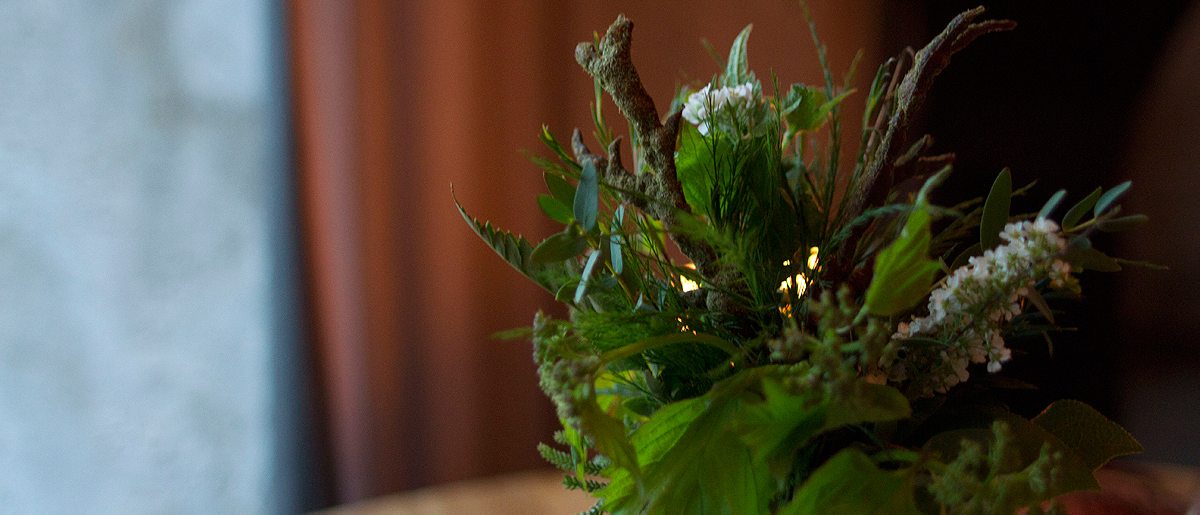
1st Course
The meal begins with a few twigs. They’ve been right there all along, in full camo inside a vase of moss and flowers. Magically a little bowl of crème fraiche appears and we are off. The sticks are made like an eggless pasta and dusted in malt. Washed down with a beer made entirely from birch sap, they taste like dead ringers for real sticks.
2nd Course
A tumbleweed of reindeer moss served on a bed of grass. It weighs slightly more than air and tastes slightly better. And just like that, I feel the pangs of preciousness creeping in already. Am I here to eat or am I here to watch a live performance of Planet Earth?
“I know exactly what you mean. It’s like someone is whispering to you but you can’t hear it.” No, that’s not Nathan, my R&K partner and dining companion for the evening. That’s René Redzepi, the man himself, chef and owner—the guy who makes Noma Noma. To be fair, he tells me this long after the meal, in a conversation we have by phone, but he then immediately denies it, saying that “generosity is the key of a meal”. But he understands my concerns, which says something. Maybe.
If you’ve seen pictures of the food before, you know what I mean: These plates are hyper-manipulated—down to the last tweezer-placed sorrel leaf—to look like some enhanced version of reality. Nature on steroids. It’s what a forest floor might look like for two minutes each spring.

5th Course
“Catch them if you can.” It feels like a hollow taunt from the server. After all, it’s a mason jar filled with ice. But when you pop the top, there they are, two live shrimp, fresh from a fjord just outside Copenhagen. Every time I make a move, it contorts just enough to throw its body an inch off the ice below. It’s still fighting—gently scratching against the roof of my mouth—when my teeth take its life.
“It makes you realize that everything you are going to eat in this meal was alive at some point,” says Matthew Orlando, Noma’s head chef, a native Californian, and the guy running our meal tonight. “It’s not just some piece of meat that comes from the butcher or some vegetable that comes from the green grocer.”
At one point, Orlando tells me, 40% of diners at Noma were sending this dish back. Delicious? Sort of. Ballsy? Absolutely.
6th Course
Smoked and dehydrated carrot served on a pitch-black bed of hay ash. “It’s how a carrot would taste to a starving man if he found it in the forest, half decomposed, and still loved it.” Nathan, globetrotting gastronome, my color man for the evening.
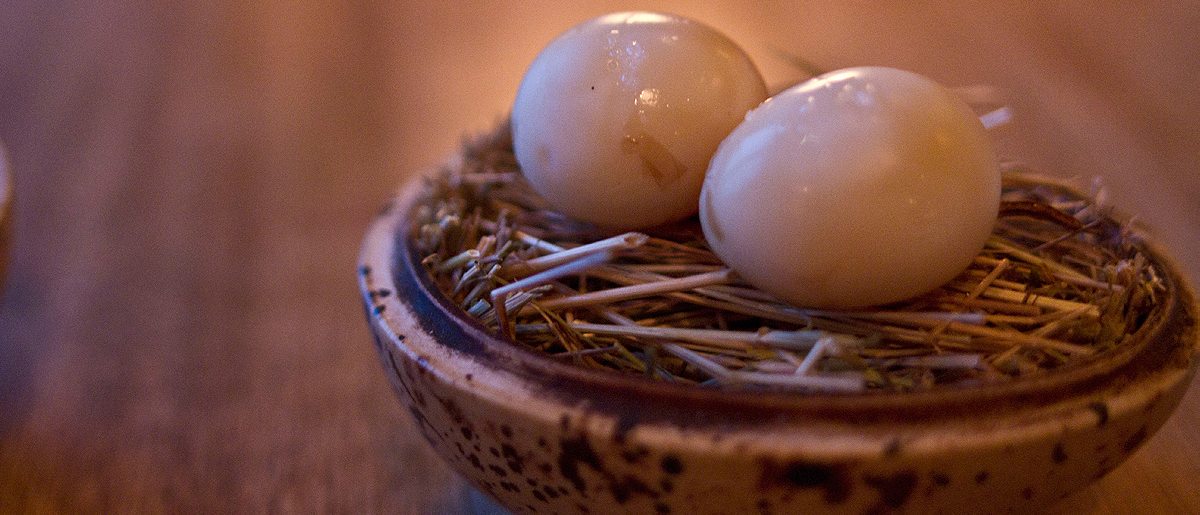
7th Course
A moment of clarity: a single quail egg, cooked sous vide, pickled in apple vinegar, flecked with crunchy shards of salt. It’s served in a giant speckled marble egg in which a milky cloud of hay smoke has been trapped. “We use an electric bong we buy in Christiania,” says the server with an impish smile.
Turns out that he’s not just a server; he’s the guy personally responsible for cooking the eggs in a 64˚C immersion circulator. One of Noma’s greatest contributions to the restaurant world has been putting the cooks themselves in the dining room. They arrive in their checkered pants and brown aprons carrying the food they spend a dozen hours a day prepping and cooking. It’s not just the fact that they can add funky little tidbits like the bong anecdote, or that they can break the dish and the cooking process down to a molecular level; it’s that the enthusiasm over a dish feels more meaningful when delivered by the hands that cooked it.
Over the course of the night we will meet a good portion of the cooking staff as they each hand-deliver their creations. Some blush like beets, others beam like Scotty, but they all know exactly what they’re talking about.
8th-10th Courses
Our table is flooded like some great Southern family picnic. You can’t drop a fork without landing on something smoked or cured or pickled. “What happens when you go to a nice restaurant?” Orlando explains later. “You sit down and the waiter comes and asks ‘Do you want this? Do you want that?’ Then you sit there and you wait for 15 minutes for something to happen. If something doesn’t grab onto you right away, then you lose interest. That’s why we just hit you. It’s our way of saying ‘this is not going to be a boring meal.’”
And so the first half hour flashes by in what feels like seconds. After the featherweight food of the first few courses, the flavors begin to match the pace—intensely crunchy, salty, smoky, sharp bites, one after the next.
A crescent moon of crispy pork skin dusted in pine powder and topped with a black currant fruit leather. (Think: stoner meets late-night convenience store, brilliance ensues.)
A finger sandwich, a tile of rye bread filled with lumpfish roe, dill, and smoked cream cheese, and topped with crispy chicken skin. (Think: everything bagel meets chicken nugget, brilliance ensues.)
Cod liver, brined, smoked, frozen, and shaved, dusted with kelp salt, then stacked in a slowly-melting curls atop a milk crisp. (Think: umami madness)

11th-14th Courses
Flower pot. Radish. Dirt. Dig up, crunch down: malt, hazelnuts, dark beer. Grass and yogurt.
Veal neck, hand-shredded into a million microfilaments and wrapped around a spoonful of crème fraiche. Seaweed: oil and powder. A crunchy, creamy marvel. Somewhere upstairs a young prep cook’s fingers are bleeding.
A crunchy wave paved with smoked cod roe, dotted with microherbs and topped with broken pieces of brown glass. Those shards are duck chips, not made from the meat itself, but from intensely reduced duck stock, skimmed like scalded milk, then crisped up on the flattop. If this bite of food doesn’t give you goose bumps, you are a stone-cold dinner date.
Æbleskiver! Translation: Danish-style donuts served at Christmas time. Only it’s May and these battered beauties are stuffed with pickled cucumber and an oily fish fried crisp—his tail and head arching out of both sides of the donut. Nathan starts coughing. Powdered sugar? Powdered vinegar. Salt and sea and vinegar brine, wrapped in the warm, gooey embrace of a perfectly fried donut. Blackout good.
Intermission
And just like that the first wave has crashed right on top of us. The flow of the meal is disarming, both because of its speed and because of the sheer variety of shapes and vessels. Rocks and mounds of moss, flower vases and giant eggs, a shield of vacated mussel shells: the serving vessels mimic the food they carry. The absence of any utensils to speak of only heightens the impact of it all, brings you closer to the food.
As individual bites, some dishes were forgettable and some were magical, but the cumulative effect is pretty stunning. There’s no chance for jitters or to even think about how hungry you may or may not be; those butterflies you have when you walk in the door (and if you don’t have butterflies, maybe you shouldn’t be walking in the door) have their wings clipped by the Noma assault. It’s disorienting and counterintuitive and by the time you’ve inhaled your last granules of powdered vinegar and downed your last drop of birch beer, you realize that your body is buzzing. And that something strange is happening here.
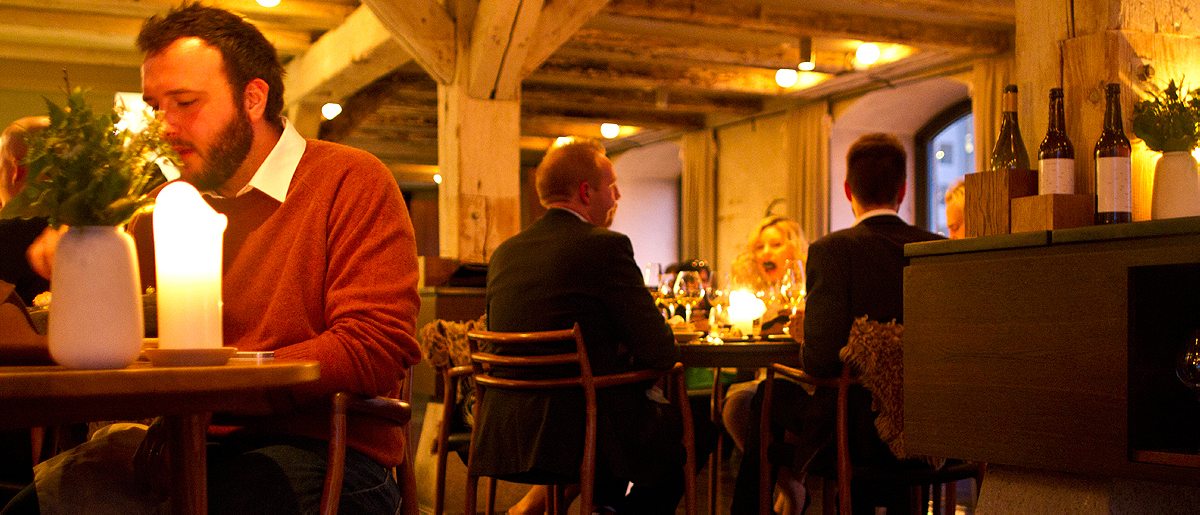
The Small Talk
“Did you guys come out to Copenhangen to dine with us?” That’s the first question we get from the sommelier. You mean, did we fly 8,000 miles and drop thousands of dollars just to eat one dinner? Seems like a ridiculous question to ask, but as I look around the room and hear the staff talking in Swedish and German and Japanese, maybe not so ridiculous…
“1204 people on the waiting list for this evening. Same day in 2008 (Monday 28th of april) 14 guests in all day. #fuckingfairytale”
This is a tweet sent out by Redzepi moments before being named number one for the third year in a row. That night there was approximately 30 times the number of guests on the waiting list as there were people eating in the restaurant. This year, Noma looks to get something in the neighborhood of a million reservation requests for just 20,000 seats. I thought my mouse click was merely fortunate; I didn’t know it was divine intervention.
Part of this crush of interest is out of genuine desire to eat great food, but wasn’t Noma serving great food on May 28th, 2008? The weight of that five-word calling card captures the imagination like no other adjective could possibly do: best restaurant in the world. People don’t want to eat in “one of the best” restaurants in the world; it doesn’t hold the same weight; it doesn’t make as good a doggie bag to take home to your friends and families.
Last year, the day after El Celler de Can Roca north of Barcelona took the second slot behind Noma, I called in the early afternoon and casually made a reservation for five for a week later. In this brave new world, where food is as much a form of conspicuous consumption as corvettes and chandeliers, second best doesn’t quite cut it.
15th Course
Bread and butter. The bane of the fine-dining experience, the filler of stomachs, the destroyer of many a great meal. The blessed breadbasket: It giveth and it taketh away. I swore it off at restaurants with hefty price tags after one too many pre-dessert carbo crashes. But it’s sitting there, warm and moist and wrapped in white like a manger child. There is something deeply intoxicating about this loaf; it exhales a warm, sour perfume that feels as ancient as food itself.
I go in for a nibble—just the tip—but end up eating three-quarters of a loaf before Nathan gets back from the bathroom.
A note to other restaurants: I don’t want sundried tomato-parmesan bread, black olive bread, walnut-raisin bread. No degustation of breads, please. Give me one loaf, exquisitely made, with the crust crisp and dense enough to break skin and the crumb soft enough to swaddle the wound. Serve it with the best butter you can find, and leave it at that.
Noma understands this. It serves just this one loaf (made with wheat and crushed oats from a small farm in Sweden) along with two magical ramekins: one with rendered pork fat crusted in crispy bits of skin, the other butter made by a small Swedish farmer who whips cultured cream with leftover whey deposits into a transcendent suspension of fat and lactic tang. They call it virgin butter, and indeed, it feels like my very first time. Together, they are the bread and butter by which all others will forever be judged.
Wine and Pine
Ever drink a Douglas fir? Of course you haven’t. Until this moment, I didn’t know conifers were juiceable. It’s the first of five juice pairings, carefully crafted, esoteric cocktails of fruits and vegetables, roots and spices, all designed to go with the high-wire dishes flying out of the kitchen. Celery and celeriac. Carrots and unripe juniper berry oil. Beet and lingonberry. Wines must be retrofitted to dishes based on acidity and spice and sweetness, but by making their own juices, Noma can tweak every last flavor inside the glass to fit the dishes they’re being paired with. If there is any advice I can offer, it is this: Skip the wines; order the juice.

17th Course
A single raw razor clam sheathed in an emerald green cloak of parsley, set in a puddle of mussel juice and dill oil that shimmers like ink splotches across the briny surface. A drift of frozen horseradish bites through the sea below. There’s a reason why this one has been on the menu since the start. If you asked for Noma in a single bite, this would be it.
18th Course
Wait, what’s that sound? I tilt my head towards the din of the dining room. Is it? Could it be? Yes, it is! Laughter, bellowing out from nearly every table in the restaurant. Rumor has it that laughter was banned from Michelin-starred dining rooms sometime back in 1982, but Noma—outlier, rebel, iconoclast—audaciously welcomes it back with open arms.
In all seriousness, laughter is a sound heard too infrequently in nice restaurants. Is it too much to expect that the fun we have be approximately commensurate with the amount we pay? I sure as hell don’t want some guy in white velvet gloves delivering me my vol-au-vent of abalone and condor egg, then whispering the ingredients into my ear like a rumor about the queen.
Here’s a typical scene from a high-end Euro or Japanese restaurant: Moneyed couples quietly knife and fork their way through course after course of exceedingly beautiful food, occasionally remark on its exquisiteness, and uncomfortably stumble their way through a meal in stilted silence, all the while thinking: “Is this what it feels like to be rich?”
It’s all vaguely awkward, even for those who espouse the joys of being pampered. More than that, it’s absolutely unfun. I made a promise to myself a long time ago never to drop hundreds of dollars not having fun.

19th Course
A langoustine the size of a smart phone comes beached across an ocean stone. Around it, tiny sea green buttons of oyster and parsley puree. A game of shellfish dipping dots ensues. No pyrotechnics here, nothing screaming “look at me cooking!” That’s not the point of this dish. This is one of those dishes you eat at great restaurants where the chef is essentially saying: “Screw you, dude, look at my product.” There’s not a serious cook in the world who could eat this dish without growing wild with envy.
20th Course
The first real misfire: Chips of dried scallops served with watercress puree and a petroleum pool of mussel juice and squid ink. Too much brine, too much metal—tastes like I’ve been tossed by a wave and held under a bit too long.
Sometimes you get the feeling that deliciousness is one of a dozen factors a chef considers when putting together a plate, rather than the only—or at least, the primary. That must always be the starting block. Despite what some may say, it wasn’t always the primary focus at elBulli (one of Ferran’s favorite ingredients, rabbit brains, doesn’t scream delicious to most diners), and it isn’t at a lot of the places that have followed in its highfalutin footsteps. It’s a fragile balance, giving the diners what they want and cooking what you think they need to try. Beef filet or lamb tripe? Chicken breast or cod sperm?
“If we put lamb brain on the menu with cocktail berries, people will probably try it,” says Redzepi. “But there’s no point in putting anything on the menu if it isn’t delicious.”
In one respect, you admire the stones on a chef who is willing to put out plates that deeply challenge (and perhaps disappoint) the diner, but it’s not enough to bend food into new shapes and textures or conjure up exotic ingredients just because you can. If I can’t taste the “why”, then what’s the point of, say, twisting foie gras like silly putty, or making a potato look like a rock? After eating at Noma, you see that it can be done without disappointing diners. Or making them feel obtuse.
All that being said, allowances must be made for the subjectivity of taste. Culture and rearing have a deep impact on what textures and flavors we find satisfying. Maybe the guy next to me is dunking his scallop chip into the inky puddle with his eyes squinted and his head waggling “yes, yes, yes!”
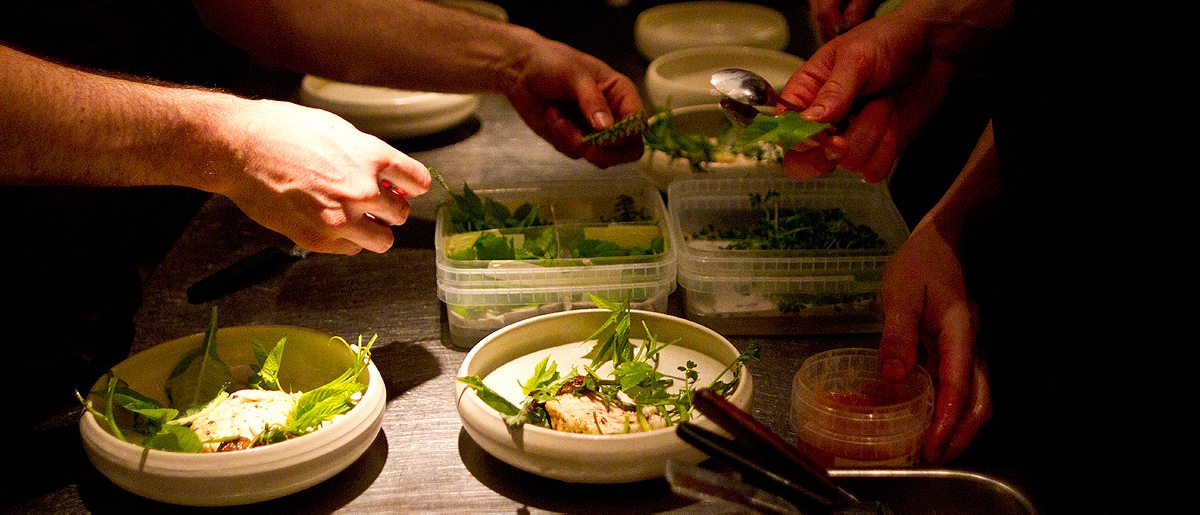
Requisite Rumination on Foraging
Many of the roots, chutes, rhizomes, leaves, and herbs we are eating tonight are brought to you by the white-clad cooks themselves, who disappear like gnomes into the forest to fill their baskets before service each day…
No one can write about Noma without talking about foraging, and no writer can interview Redzepi without asking him for a demonstration. It seems like a dozen brave scribes have wandered into the forest with René to have him reveal the generosity of Mother Nature. Eater.com coined this new genre of stories the I Foraged with Rene Redzepi Piece (IFWRRP). Nathan and I discuss the possibility of getting Redzepi to go dumpster diving with us in Christiania, but luckily for him, he’s at UCLA tonight, giving a speech to an auditorium of Angeleno academics. You lucked out this time, Redzepi.
Søren Wiuff, Denmark’s legendary farmer and a major supplier to Noma, has his doubts about Redzepi’s crew of forest frolickers. When I visit him at his farm, he tells me that “foraging should be left up to the professionals who do it everyday,” not to a team of stagieres set loose in the forests and along the shorelines around Copenhagen. When I catch up with Redzepi later on the phone, he doesn’t disagree:
“I feel it would be better if it was organized and done by people who were trained to do it. We are cooks, but the way that it is it’s not organized, so we have to do it ourselves. So of course it’s shaped our way of thinking about food.”
Over the course of the meal, nearly every bite bares something snatched from the wild: an emulsion of sorrel, a tuft of ransom, a thicket of sea spinach. It’s not just about looking pretty, or about dropping the f word on diners easily won over by a story; more than anywhere you’ll eat right now, the foraged goods at Noma are there for calibrated effect: garlic, acid, spice, bitterness are all enhanced by the Noma scavenge.
22nd Course
A tiny cast-iron skillet arrives at the table screaming hot. Orlando douses it with roasted hay oil and offers up some instructions. “You’re going to cook the egg for two minutes. Then you’re going to add the butter, stir in the greens, and season it all with salt…” We crack the eggs as he returns to the kitchen and just like that, we are cooks in one of the world’s best restaurants.
Tsssss….tchaaak..chaaaak. Alone with our eggs, heads fuzzy with booze and pine juice, we do our best not to mess this thing up. The oil (infused with roasted hay) spits, the egg (laid by a wild duck with a massive burnt orange yolk) crackles, and the butter (that same glorious stuff that comes with the bread) and ramson and sea spinach (gathered by the chefs) sizzle a glorious tune. You hear it from all sides of the room throughout the evening, but suddenly you’re the one making the music.
Later come a pinch of salt, a scattering of fried potato coils, and a generous few spoonfuls of wild garlic sauce. “If you don’t like it, it’s your own fault,” is Orlando’s parting shot before the sunset yolk is breached. Eventually, all that is left is the scraping of forks, the grunts of pleasure, and the incoherent mutterings of a man eating the best egg of his life. I’ve watched ambitious restaurants try to play with sound and taste for years. Normally it’s artificial—crashing waves or rustling leaves, a crackling fire piped in from an ipod. It’s elevator music; this duck egg, by comparison, is a symphony.
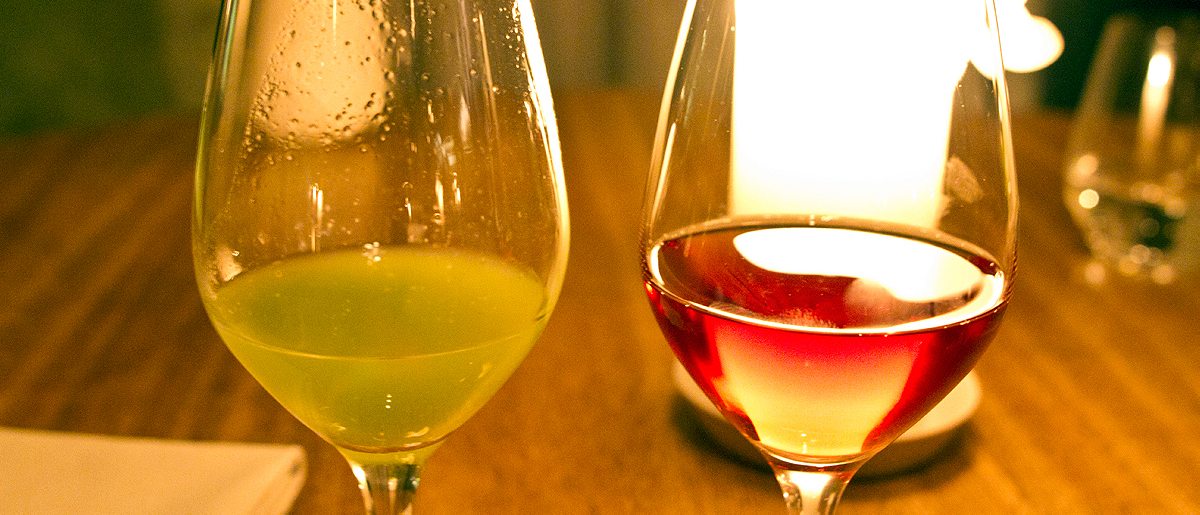
23rd Course
The last savory course of an ambitious tasting menu normally means a hunk of red meat—braised lamb neck, veal breast, beef cheek—but in case you couldn’t tell by now, Noma doesn’t care much for fine-dining formulae. Instead, a cook brings out a cast-iron pan filled with a massive, sizzling turbot steak, which has been roasted on the bone and basted into submission with an absurd amount of brown butter and herbs. After showing off this fabulously bronzed hunk of fish, it goes back to the kitchen to rest for 10 minutes, just like a good piece of beef. “We didn’t think twice about not serving meat,” says Orlando.
Nor should they. This is easily the meatiest piece of fish I’ve ever tasted, as intensely savory and satisfying as the slow-cooked off cuts that you’d normally find at the end of a meal like this. After being carved from the bone, the turbot is slathered with its own roe, buried in a forest of foraged leaves and wild mushroom slices and set afloat in a tea made from dried ceps and berries. The last time I sipped mushroom tea I spent the better part of the evening in a corner talking to myself, and everything—the sweet watermelon flavor of the fungus, the butter and brine of the roe, the unbelievable savoriness of it all—suggests that tonight might end in a similar manner.
24th-26th Courses
Dessert has come. I think. There is ice cream made from Danish bitters and a disk of yogurt whey frozen solid on top, but there’s only the vaguest suggestion of sweetness.
Standard high-end restaurant practice dictates that the dessert stage unfolds more or less in the following fashion: light, palate-cleansing pre-dessert, fruit-driven first dessert high in acidity, knockout chocolate intensity, usually involving chocolate cooked, sculpted, and spiked into various iterations of a general theme. The supporting cast—hazelnuts, passion fruit, tea and herbal infusions—are as predictable as the order in which they will arrive. It’s a three-part blueprint that has been baked into the mind of nearly every great chef the world over.
Noma clearly missed the memo. Everything is cold, but nothing is particularly sweet. Redzepi is on the record as not liking sugar, and it shows. In fact, if no one said anything, you might not even know that the meal had hit its savory apex and was now sliding inevitably towards its lightly sweetened conclusion.
After the bitters ice cream comes Pear and Pine: half a pear grilled until blackened, then peeled and served with pickled spruce shoots, pear aquavit, lemon thyme, and a spruce parfait dusted with juniper salt. The last dish is the only one that feels like it was intentionally created to be a dessert: a ruby pool of rhubarb juice with an ivory island of milk curd and tiny archipelagos of brown cheese shortbread. “I’m not sure I understand,” Nathan offers after many minutes of silence.
These are complex, esoteric compositions, but as you eat them, you feel like maybe you’re missing something. The beauty of the plate, the depth of the description, the excellence of all that has come before this bite leads you to believe that is your own deficiency that has created the letdown—which may actually be true. There is sweetness, yes, but there are many of the same effects that came before it: bitterness, salt, smoke, acid. In a four-hour, foot-to-the-floor feast, it’s a gentle easing off of the accelerator.
You’re left thinking: Is this how it ends?
The Bill
The numbers look a little something like this: 26 courses prepared by 40 chefs hailing from 19 different countries served over the course of four and a half hours. Of those courses, 14 of them were stunning, eight were excellent, three were confusing, and one just wasn’t good. When it comes to batting averages, that puts Noma in the Ted Williams camp.
The biggest number of the evening? $902.47. That’s the pre-tip damage. Staggering, yes, but the hard math paints a much gentler picture: Subtract the wine and juice pairings and the cost per dish works out to be around $11 a dish–what an order of Buffalo wings might run you at Applebee’s in Times Square.

The Aftermath
They give us road beers—Noma beers, of course, made exclusively for them by cult microbrewer Mikkeller—for the short stroll through Christianshavn to our little rented apartment. In the canals around the restaurant, boats bob with the shifting tide. Splotches of amber light dance off the water. There is no one out. No one around to notice the stupid smiles on our faces, the triumphant klink of the thick beer bottles, the warm silence of it all.
If you’re going to eat at Noma, don’t let a cab whisk you back and forth. Take the train to Christianshavn and have a stroll along the canal. Take in the boats, breathe in the sea, let the dim lights of the warehouse district lull you slowly back to reality after a four-hour feast. A meal like this needs to be bookended by quiet, reflective moments, by full consideration for what lies just before—and, eventually, painfully, behind—you.
Food has always been a way for people to tell stories: Pot au feu tells the tale of French housewives transforming scrap meat into luxury through the alchemy of slow cooking. Gazpacho is the story of sunbaked Andalusian laborers looking for a way to take the bite out of the southern Spanish sun. Even luxury bites come with their creation stories: The salmon cornet, the start to every meal at the French Laundry and Per Se, is the story of a whimsical Thomas Keller and his childhood days at the scoop shop.
But Noma’s dishes themselves don’t tell concrete stories as much as occupy a vast, interweaving narrative, one that speaks of a new age of cooking. It has most of the hallmarks of great food of the modern age—technical refinery, perplexing combinations, whimsy—but they’re strung together in a way that makes them wholly unique. This is not the lovechild of the French Laundry and elBulli, even if those are the two most readily apparent antecedents to this cooking. This is not molecular gastronomy, modernist cuisine, or even New Nordic. The meal tonight was the first chapter in a novel waiting to be written.
Still hungry? Check out a slideshow of the full Noma tasting menu. Or a video of Noma’s young cooks testing out their own dishes on Redzepi and the senior chefs at the restaurant.